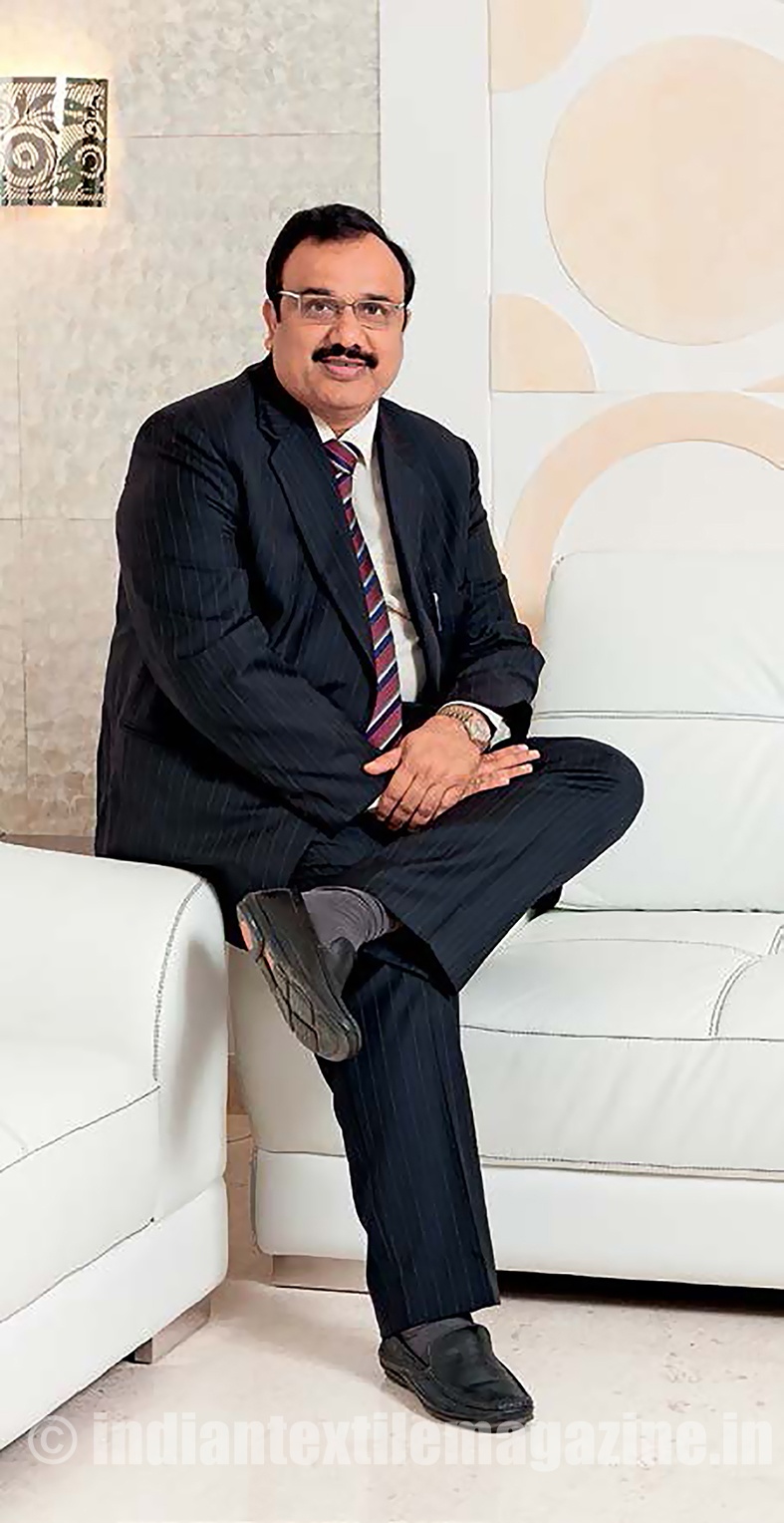Lux is one of the leading players in the premium branded innerwear space. Incorporated in 1957 by the visionary, late Mr. Girdharilal Todi from a small tenement, Lux Industries has today transformed into one of India’s largest and fastest growing innerwear companies. With a wide range of more than 5,000 SKUs for men, women and children, manufactured across 11 facilities strategically spread in the country, the company’s brands are available across around 5 lakh outlets, pan-India. Lux Industries’ turnover and net profit has surged at a 12.57% and 43.73% CAGR (compounded annual growth rate) over the past five years, with total income and net profit standing at Rs. 941.16 crore and Rs. 51.34 crore respectively, in 2015-16.

In an exclusive interview with The Textile Magazine, Mr. Pradip Kumar Todi, Managing Director, Lux Industries, gave detailed insights into the company’s recent performance, the Indian apparel and innerwear sector, and the long term plans of the company.
Here are the excerpts.
To a typically unorganized segment, Lux has brought forth an institutional culture that is most visibly reflected in its technology orientation. The company’s growth story has been characterized by continued focus on premiumization, portfolio expansion in existing product segments, venture into new segments, distribution expansion in existing markets, and also penetration into upcoming growth centers. In 2016-17, Lux expects a revenue growth of about 10% that will enable the company to cross the historic 1,000 crore mark in turnover.
Expressing immense satisfaction in the company’s performance during 2015-16, Mr. Todi said: “The strength and resilience of our business model is evident in our financials. So while our total income grew at a slower pace of 3.52% to Rs. 941.16 crore, our EBIDTA surged 16.52% to Rs. 94.86 crore with a corresponding growth in our EBIDTA margin of 112 bps to 10.08% during 2015-16. This performance is one of the best in the organized Indian innerwear industry and is an outcome of our consistent focus towards premiumization. Among other initiatives, this focus also bolstered our net profit growth by a sharp 13.51% to Rs. 51.34 crore during the year under review. If one should appraise our performance over a slightly longer period, we have turned in 12.57% CAGR in gross sales, 33.48% in EBIDTA and 43.73% in net profit over FY11-16, a period that was characterized by challenging macros. Superior brand equity and positioning as a premium yet-affordable brand have been the key contributors to this growth.”
Premiumization
Lux Industries is known for its focus on premiumization. Elaborating on the strategy, Mr. Todi observed: “Lux Industries offers a compelling, long-term, capital-efficient, lifestyle play on the premiumizing innerwear category. According to reliable estimates, almost 80% of the innerwear category is still standard which offers a significant pathway for premiumization-led growth.”
Continuing further on the topic, Mr. Todi said: “We are focusing on our premium brand ONN to derive better margins in the hosiery segment and we are doing so on the back of establishing exclusive outlets and signing film stars as ambassadors. ONN is growing at a rate of 30% unlike the rest of the mass market brands such as Lux Cozi and its franchise. We launched ONN almost four years ago with Shah Rukh Khan as its brand ambassador. While highlighting this point, I must mention that Lux Industries was one of the first players in the hosiery industry to rope in celebrities for the category. We had actor Sunny Deol endorsing Lux Cozi innerwear 15 years ago and now we have Sushant Singh Rajput and Dev as our new ambassadors for the mass brand. Our new and extensive brand campaign with Sushant was received positively in the trade and helped differentiate our brands vis-à-vis those of our competitors. We also recently launched the GLO collection as a sub-brand of Lux Cozi.”

According to Mr. Todi, aggressive and focused marketing initiatives helped establish the Lux Cozi GLO collection as one of the fastest growing economy to mid brands in the men’s innerwear space. “I must emphasise on the fact that we have a wide collection of multiple successful brands and the brand charter ensures scientific brand plans for each of these” added Mr. Todi.
Expansion Plans
One of the biggest highlights in recent times for the company has been the establishment of a new plant. “We prepared the foundations for our new state-of-the-art 6 lakh sq. ft. (approximate) manufacturing facility in Dankuni, West Bengal. This integrated facility has the capacity to produce 5 lakh units of finished products a day and our technology orientation for this plant is visible in the fact that we have imported German knitting, Italian cutting and Japanese stitching machineries that are being deployed to improve quality of the products and reduce cost. These machines from three different countries for three major garment-manufacturing processes are considered to be the globally-best in terms of technology.”
The unit is expected to fully come on-steam by September 2016. Mr. Todi also stated that three small manufacturing units in and around Kolkata with less productivity are also being merged and shifted concurrently, which will help the company save on rent and also turn the assets into large, useful warehouses.
Adding further on the company’s focus on expanding its manufacturing facilities, Mr. Todi said: “Even while we are at advanced stages of operationalisation of our new asset in Dankuni, we are already planning for Phase-II expansion that seeks to double the production capacity of the unit over the next 3-4 years. With this new plant, we have a total count of 11 manufacturing facilities, which also includes having a base in garment hubs such as those of Tiruppur and Ludhiana. However, most of our plants are in West Bengal since labour is abundantly available with adequate availability of infrastructure for hosiery manufacturing.”
Export Performance
Speaking on the company’s export performance during the year, Mr. Todi pointed out that Lux Industries remained the largest exporter of innerwear in India with total export sales of Rs. 117.31 crore in 2015-16, which contributed to 12.62% of the company’s gross income during the year. He added that the slowdown across most global markets coupled with geo and sociopolitical strife, resulted in a flat export sales share in terms of value and volume during the year. The company exports its products to the whole of Africa, the Middle East, Singapore, Malaysia, Australia, and North America. “During the current year, we are actively exploring the markets of Korea and Western Europe and hope to normalize export-driven growth over the near future” added Mr. Todi.
Mr. Todi is optimistic about the continued growth of India’s apparel and innerwear industries. “Indian apparel market is valued at about $40 billion and has grown at about 8% over the past few years. A surge in demand for readymade apparel (for convenience, design and variety) also catalysed by thee-commerce boom, rising income levels (driving increasing discretionary spends), youth demographics and increasing preference for branded apparel (growing presence of the organized retail and online channels) are driving market resurgence.”
According to Mr. Todi, the Indian innerwear market stands at about Rs. 20,000 crore and has grown faster than the apparel market at about 11%. The market is characterized by a large unorganized segment. However, favourable macro-economic factors like rising incomes, attractive demographics on the back of a large population, rising urbanization and a higher proportion of working women are together driving the shift towards organized branded innerwear.
Positive Outlook
Speaking about the gradual evolution of the innerwear market segment, Mr. Todi said “From being traditionally considered as an essential commodity, the innerwear category is increasingly witnessing a shift from being functional into a fashion category and from a price sensitive into a brand-sensitive category. Besides, the per capita spends on men’s and women’s innerwear is miniscule in the country even as compared with some of the much smaller Asian nations like Thailand. Together with accelerated growth in market share in the hands of the organized segment of the innerwear industry, a rapid correction in per capita spends is likely to drive the sector’s growth at a 13% CAGR between FY13-23, throwing up huge opportunities for frontline players like us.”
When asked about the initiatives required to be undertaken by the company to drive growth over the medium term, Mr. Todi responded by saying that the company will continue doing what it does best, which is knitting. He also added that widening the product and brand portfolio coupled with distribution-side development will help in market share expansion and drive multiple years of growth for the company. “Moreover, as seen over the past two years or so, our strategy towards premiumization is yielding results and we expect to aggressively augment this initiative with a strong focus on profitability-driven growth. Overall, we expect to register an 8-10% growth in our gross income in 2016-17” concluded Mr. Todi.